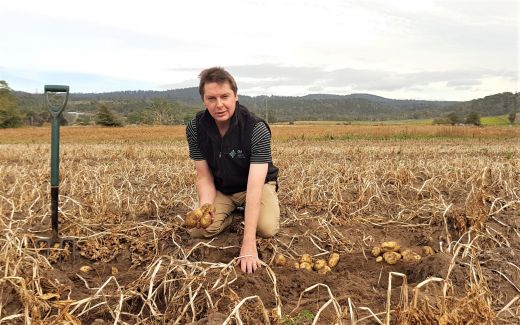
A new project by the Tasmanian Institute of Agriculture (TIA) will support the ongoing sustainability and profitability of Tasmania’s potato industry.
The two-year project, led by TIA Senior Research Fellow Dr Robert Tegg, aims to develop recommendations that will assist growers better to manage the impact of pink rot disease in potatoes. The research will focus on understanding the role that soil pH, acidifying fertilisers and elemental nutrients play in the occurrence of pink rot, and whether these can be modified to improve outcomes for growers.
“Pink rot is a serious problem for potato growers around Australia and particularly in the key potato-producing regions of Tasmania. This season has been tough for Tasmanian growers, and it’s predicted that the industry will experience severe losses in the current growing season,” Dr Tegg said.
“Pink rot disease is characterised by a pink colouration and distinctly unpleasant odour. It causes rapid rotting of potato tubers, whether in-ground or in storage, and results in significant yield losses and product downgrades or rejection.”
Potatoes are Tasmania’s highest value vegetable and an increase in production volume last season saw the farm gate value grow by 11 per cent to $123 million, with a processed value of $435 million.[i]
Dr Tegg said there was an urgent need to identify effective control methods to support the industry’s sustainability and profitability into the future.
“Current control strategies, specifically fungicide usage for pink rot control, have become less effective in recent years,” Dr Tegg said.
The project will include pot trials, targeted field surveys of 20 potato paddocks, and two field trials in collaboration with local growers and agronomists.
Jo Tubb, Simplot Australia Potato Agricultural Manager, said pink rot was a serious soil-borne pathogen that renders some of the highly infected paddocks in Tasmania to be unsuitable for potato cultivation.
“Some potato paddocks experience a regular substantial yield loss ranging from 5 to 30 per cent even when current recommended fungicide treatments are applied. Therefore, any research that can help us to understand the epidemiology of pink rot, the interactions between the pathogen and the growing environment, and its potential control would be of benefit to the potato industry,” Ms Tubb said.
The project ‘Investigating soil pH and nutrition as possible factors influencing pink rot in potatoes’, is funded by Hort Innovation using potato industry levies and contributions from the Australian Government.
TIA is a joint venture of the University of Tasmania and the Tasmanian Government.
[i] Tasmanian Agri-Food Scorecard 2017-18








